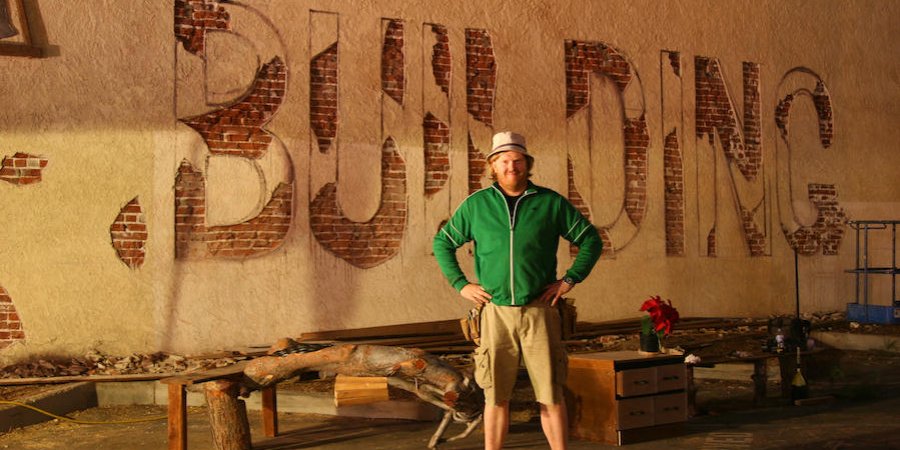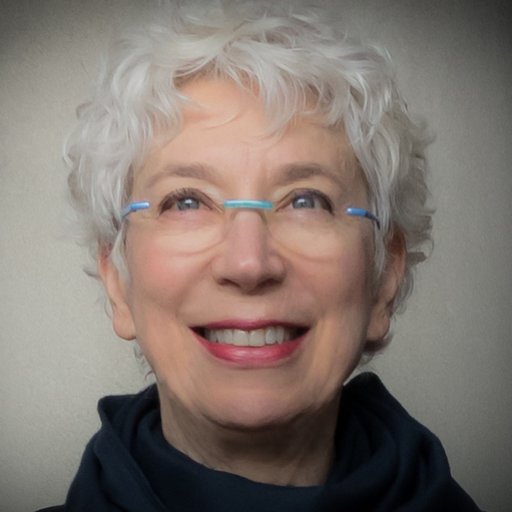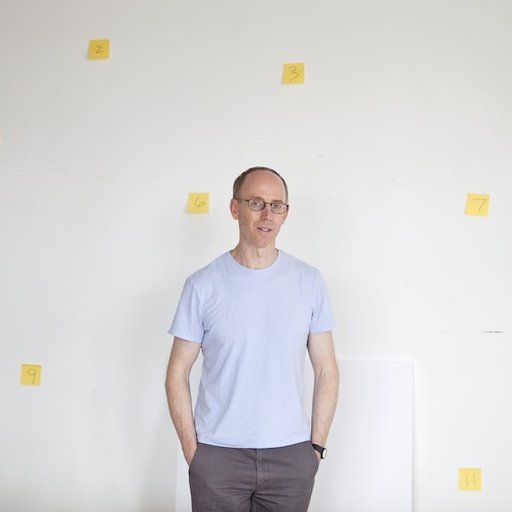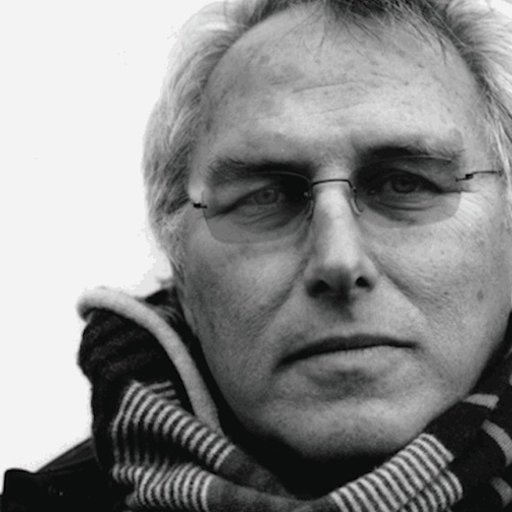As Jason Middlebrook tells it, his art about environmental degradation is optimistic. That’s not immediately apparent. From a hulking Louise Bourgeois-like uprooted tree-root system to a spooky, post-apocalyptic model of theGuggenheimBilbao to hundreds of plastic bottles cast in concrete like archeological relics from the future, each of his ambitious paintings, sculptures, and installations depict the contest between man and nature, often made with recycled detritus or salvaged objects. “The underlying idea is that nature is going to kill us all,” he says with a laugh. Recently decamped from gentrified Williamsburg to upstate New York's pastoral Columbia County, Middlebrook reports that “nature’s winning up here”—an observation shaping his day-to-day living, and his art.
Today, his naturalist sensibility plays out in his new art bartering post at the Site: Santa Fe Biennial, “Unsettled Landscapes,” which this year centers on themes of land, territory, and trade. For the festival, the artist has refurbished a Korean-brand shipping container and stocked it with work made by over 30 of his artist friends: a bevy of birdhouses, jars of glass marbles, stained glass, and paintings of owls by Middlebrook. And that’s just the starting inventory; the traded goods change every day, as collectors swap their own creative wares with a tasked intern force.
Back from the Southwest, the 47-year-old artist, who graduated from the elite Whitney Independent Study Program in the 1990s, spoke to Artspace about extracting art from the superheated market, why New York has a 15-year expiration date for artists, and finding a dead opossum in his new studio.
You’re just back from Santa Fe—could you tell me about Your General Store there? What was the genesis of the project?
The original idea came from seeing this old gas station at the end of my street in Columbia County that reminded me of a kind of bartering general store from the 19th century. But instead of just serving people’s basic needs, I wanted to include artwork by my friends. That way it became an almost sculptural object—a bartering art project, forcing people to make things instead of buying them. "Your money’s no good here." It was so cool to take money out of the equation, because the art world is so wrapped up in it these days.
 Inside Your General Store (2014)
Inside Your General Store (2014)
Have there been any unexpected swaps or surprises so far?
I’ve had to teach the interns to say “no” to people bartering, because we want to keep the inventory pretty high. If you have a Rembrandt drawing and someone wants to trade a bar of soap, you just can’t do it. So we had a couple early trades, where I said, “Dude, you can’t give this stuff away for garbage. What do you think would make a fair trade?" They can’t go to fucking K-Mart and buy an oilcloth for an oil painting. You can’t do that. A trading post would say “no.” I’m not going to give you 30 pelts for 20 pelts. Like, you’re crazy!
What about good swaps?
Yeah, my good friend Letha Wilson, who just bought a little house up here, found a halved birdhouse on her property, and we made a front for it. And then a woman in Santa Fe found a birdhouse on her property, and traded it for Lisa’s, which was really cool. There’ve been a couple really good ones like that right off the bat.
You often work with recycled materials in your work, from plastic bottles taken from the dump to the locally sourced timber you use in your plank series. You’ve said before that your grandmother from Arkansas, who—as one of 14 children—instilled in you an aversion to wastefulness. What do you hope to suggest by repurposing a shipping container?
In my grandmother’s generation, you had really poor, salt-of-the-earth people living off the land and recycling everything that they had for economic reasons. In our generation, on the other hand, we don’t have time to do that. It’s easier to go to Target or Amazon and order something that UPS or FedEx delivers the next day. The shipping container suggests global mobility—a form of transportation of goods that’s really slowing down. Only in the last 50 or so years have we been using shipping containers to move things around the world. Today, though, people are not willing to wait for high-end goods. Sure, if you go into K-Mart or Wal-Mart now, you buy the towels or a rubber ducky or whatever that was probably on the sea for two months. But if you go into a high-end store or buy something from Amazon, that was probably flown here overnight or within two or three days. So I think the shipping industry is going through this major transformation because people aren’t willing to wait for their high-end stuff.
So there are so many shipping containers available now, because people aren’t using them as much. They become these multipurpose things. I mean, Jeffrey Deitch even put on a show 10 years ago with LOT-EK about how shipping containers are being converted into houses. People’s needs are changing, and economies are changing. Maybe people will be using them for relief housing after a hurricane, which has already happened with Katrina and Sandy. So the form is going through a major transformation. It’s really cool, and it reflects how people are living in the world.
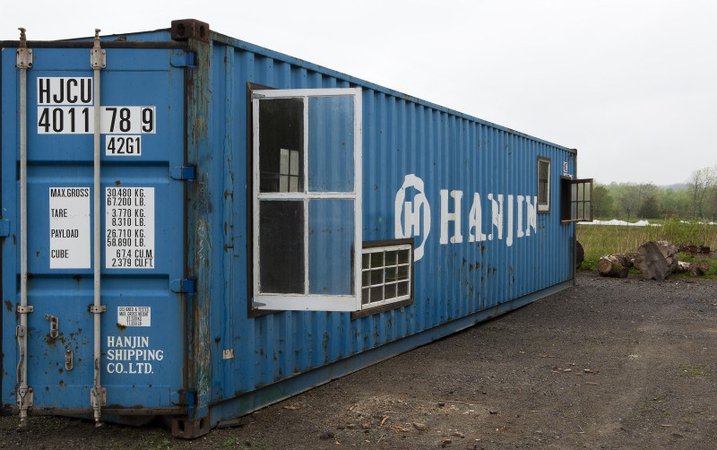 Another view of Your General Store
Another view of Your General Store
Where did you get the shipping container?
The company’s Korean, but I bought it in Newark and I think it has 10,000 shipping hours or something. I wanted one that had a little bit of character, and I cut nine windows in it and covered the inside with wood so you get a patina of time, but not neglect. This thing still has some life to give in it.
Picking it out was really fascinating. I went to Newark and there’s a whole process. It’s literally a container city—they’re stacked like 10-high. You go there and walk in the yard and say, "I want that one," and "that one" could be 60 feet in the air, but then they come with this forklift and bring it down and you go inside it. And it’s not that much money—it was like $2,900 with delivery. I could sell this to a bar in Brooklyn and be done with it: a whiskey bar, ready to go.
Were there any other art storefront projects, like Gordon Matta-Clark’s 1972 Food restaurant that inspired the general-store project?
Gordon Matta-Clark's project, for sure. And if you look at my art-house project, it was called More Art About Buildings and Food, based on the Talking Heads record. You can see how influenced I was by Gordon Matta-Clark, or even Rirkrit Tiravanija, whose projects became a catalyst for this kind of exchange.
What do you hope becomes of the Your General Store?
I want it to travel beyond Santa Fe and be on a tour for a year so it affects people’s lives outside of the art-world context. I want it to become regional. Now it’s about Santa Fe, and then, at the next destination, it can become about that place. That would be the goal for me: that it lives beyond the art world. Sometimes the art world scares me a little bit because it’s so narrow. If it travels and goes to a school or goes to a community, I’ll be really happy.
You recently moved to Hudson from Brooklyn. Has your recent move to the country inspired this more communal approach to experiencing art?
There’s definitely that kind of camaraderie that exists in manual-labor communities that you don’t get in the city. When you live in farming country, like in Columbia County, there’s often the sense of, “Hey, I’m stuck in the mud, help me out and I’ll bring you a dozen eggs tomorrow." Or, “Hey, there’s that guy Steve, he was so sweet, he let me borrow his tractor. I want to do this or that for him.” In the city, the exchange, if it happens, is closer to, "This guy did some Photoshop work for me so I’ll housesit his cat," or something like that. But that’s rare. You hire someone to do the Photoshop. Money is so much easier to come by than time in the city. You’re just a number in there, whether you want to admit it or not. But up in the country, there’s a little more of a personal touch.
 Underlife (2012–13)
Underlife (2012–13)
Do you feel like you’ve missed out at all as an artist by moving upstate?
The only thing that I miss is a more intense relationship with artists, but as you get older you don’t need that as much. When you’re like in your 30s, you need a dialogue—you need to go to openings and you need to see new bands. But when you’re in your 40s and you have a family, you just need to make art. And I frankly kind of got burned out with Brooklyn artists, because it’s either like, “How’d you get in that show” or, “I’m too famous to talk to you.” Once you get established, I found it harder to work there.
What do you mean?
The distractions get bigger and the noise gets bigger and then the pressure gets bigger and then there’s always someone who’s doing better, and it’s in your face. There’s always some gallery opening, some new star. The competition is always there to remind you that you’re not as good as you think you are—which also keeps you good, keeps you sharp. But I found that in the country there’s less pressure, more freedom, and you become slightly more exotic. Remember when Ashley Bickerton moved to Bali? That was pretty fucking rad, and, if anything, it made him better. I think New York, between 10 to 15 years, is awesome. But more than that, trouble.
How has being closer to the natural world reformed your art?
In the city, I was really interested in the head-on collision of man and nature. I always loved the metaphor of tree roots breaking through the sidewalk. You see them on every street corner in New York, growing around the fence, cracking the asphalt. But since moving to the country, I’m not so interested in that deconstruction of architecture—I’m more interested in the nuances of nature, and how I can put my imprint on that. Have you ever seen an abandoned parking lot of a shopping store with hundreds of weeds growing over it? If you put a hard, man-made surface over a natural environment, it’s going to crumble in 50 years. But maybe you use different materials and design it so the river can flow through it and the light can permeate it—if you design with a conscientious mind knowing that nature’s going to dominate—I think we can navigate the world a little smoother than we have been. Since nature’s going to eventually do us in anyway, we might as well address it delicately.
So nature prevails. Is that what your acclaimed plank series is about, in which you overlay local timber planks with delicate geometries and abstractions?
Right. No matter what I paint on those planks, I have to take into account that the tree did so much more work than what I did. The tree lived for a hundred years, and it compressed all that time into the grain. Every time I do a plank painting, I’m trying to respect nature, but also create my own parking lot, my own highway. I wasn’t ready to make that kind of work when I was living on Bedford Avenue in Brooklyn and showing a lot. I was trying to set up that dichotomy, but I hadn’t found the wood yet or the language. So I think that’s what the planks are about, trying to draw attention to the tree, draw attention to the form, and then delicately make a statement with my hand. Because the tree is the narrative.
 Middlebrook's Plank series
Middlebrook's Plank series
Along with the general store, you’ve done several public art projects, from Underlife (2013) at the Albright-Knox Art Gallery to the Brooklyn Seeds mosaic work in the subway station. Do you approach public projects from a different place than work to be shown in a gallery?
Oh, totally. White box galleries suck. You’re just showing byproduct in a weird way. The public art projects are so much more interesting. They engage so many more people and are about the place. They have to function and withstand many years and elements. That’s why I got into the earthwork artists, because I think they suffered the same dilemma so they went West and made these monumental things. I did like 15 or 20 solo shows in New York and it was always like, “Oh god, how do I deal with a white cube?” And I always try to even look at the floor plan and look at the gallery show to make it into a site-specific project.
A teacher once called you “conceptually promiscuous.” Often handcrafted and tactile, your art is difficult to categorize. Could you talk about what you think unites your wide-ranging body of work?
Sometimes I don’t get put in certain conceptual camps because the end result looks tactile or decorative or maybe there’s a physicality to the paint or to the object. It doesn’t look like a Wade Guyton or a Seth Price, even though there might be as much conceptual trimmings to it. There’s more of a dependency of craft or the hand made. But I think every time I get the opportunity, my work is about place, or it’s about the predicament of place.
Where does your sense of a natural world come from?
California. I grew up where Apple started, but when it was from this cool, hippie part of the world. Later it became really corporate of course. Companies like Apple kind of fucked up the Bay Area a little bit. It was a really cool counterculture environment, with the Grateful Dead and Jefferson Starship. It went from being populated by Patti Hearst and fucking weird Black Panther-like groups to millionaires overnight. So when I go home, it isn’t the same—Northern California is not that counterculture hippie idea that I remember. My wife and I found that up here though in Columbia County. I think the kind of post-Woodstock, organic-farming community here reminds me of a lot of what Northern California was in the ’70s and ’80s.
Has living upstate changed your understanding of the natural world?
It’s wild up here—really wild, way more than I thought. There are deer in our yard and snakes in our basement. Nature’s winning up here. So I think that with owning land and having a garden and raising kids and playing with animals and burying raccoons and finding dead opossums in your studio, every day I’m tackling something. I’m in contact with nature every day.











